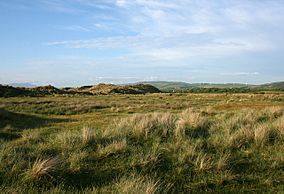Sandscale Haws facts for kids
Quick facts for kids
IUCN Category IV (Habitat/Species Management Area)
|
|

Sand dunes at Sandscale Haws
|
|
| Area | 282 ha |
|---|---|
Sandscale Haws is a special place in Cumbria, England, where nature is protected. It is a national nature reserve located on the Duddon Estuary. The National Trust takes care of this beautiful area. Many animals live here, including the rare natterjack toad.
Contents
A Look Back: Sandscale's Past
Sandscale Haws has an interesting history, even though it's now a nature reserve. Long ago, people used the land for different things.
Early Industry and Mining
Around 1850, there was a brick and tile factory at Sandscale. Later, in 1877, a company called the Sandscale Mining Company started digging for minerals. The owner of the land, Thomas Woodburne, signed a deal for the mining. He also built cottages in 1882 for the people who managed the mines.
Another company, Kennedy Brothers, took over the mines in 1893. They worked the mines until 1905. Even after the main mining stopped, pumps kept working at one of the mine shafts until 1937. These pumps helped other nearby mines. At first, they used steam engines, but later, in 1928, they switched to electric pumps.
Wartime Use and Land Changes
During World War II, the sand dunes at Sandscale Haws were used as a "decoy site." This meant they were set up to look like something important to trick enemy planes. You can still see some brick buildings from that time.
In 1954, a company called British Cellophane bought the land. They built a new farmhouse and took down the old one. Later, before their local factory closed, they sold the nature reserve part of Sandscale Haws to the National Trust.
Amazing Wildlife at Sandscale Haws
Sandscale Haws is home to many different plants and animals, especially because of its unique sand dunes.
Meet the Natterjack Toad
The reserve's sand dunes are a perfect home for the natterjack toad. This toad is very rare in Britain. It has special ways of living and can breed in temporary pools of water that appear after rain. Another amphibian you might find here is the great crested newt.
Protecting Nature
Sandscale Haws is part of a larger protected area called the Duddon Estuary SSSI. SSSI stands for "Site of Special Scientific Interest," meaning it's very important for its plants, animals, or geology. This area is also protected by European Union rules for wildlife.
- The Duddon Estuary is a Special Protection Area because it's a vital place for birds. Many waders (birds that feed in shallow water) and wildfowl use Sandscale Haws as a safe place to rest when the tide is high.
- Sandscale Haws is also part of the Morecambe Bay Special Area of Conservation. This protection helps keep the natural habitats safe for all the creatures that live there.
Visiting Sandscale Haws
If you want to explore Sandscale Haws, there's a car park where you can leave your car. From there, you can walk on a special boardwalk that leads to the beach. The boardwalk also takes you to pools where you might spot amphibians like the natterjack toad. It's a great place to enjoy nature!


